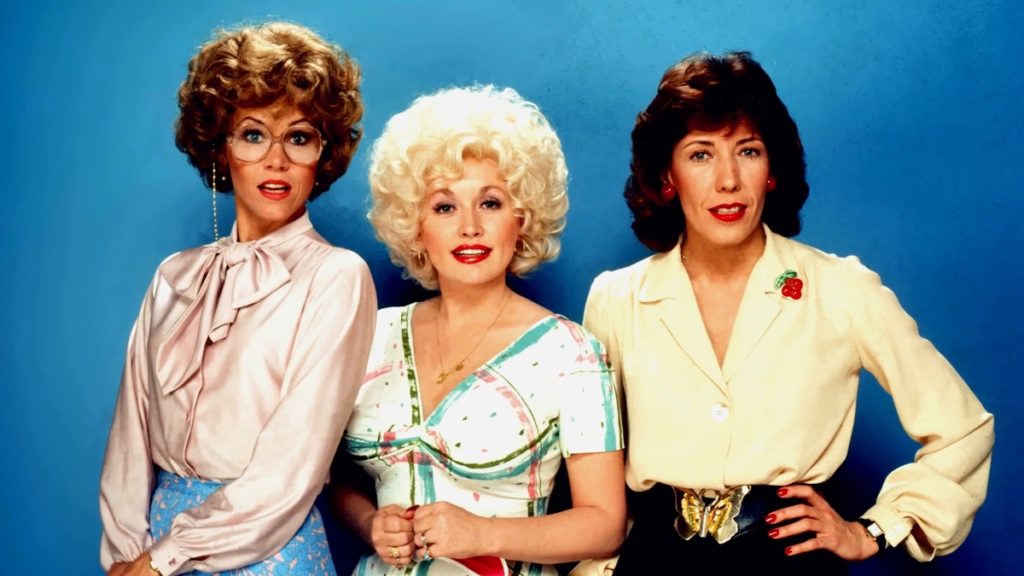If you are a woman, it is highly probable that one has endured one or more unfortunate conditions of a patriarchal workforce: Sexual harassment, office wifery, and pay inequity. Filmmakers Camille Hardman and Gary Lane’s Still Working 9 to 5 bank on these globally shared experiences as a draw-in to their standard documentary retrospective on the plight of the female office worker, Colin Higgins’ monumental 1980 comedy 9 to 5.
The iconic female co-leads Jane Fonda, Dolly Parton, and Lily Tomlin recall the production and resulting success of the comedy that resonated with millions of women. Some of whom were active in public protests to draw attention to systemic unequal pay structures that almost always leveraged the opposite sex in the workplace. Both Fonda and Tomlin were involved in advocating for the passage of the Equal Rights Amendment (E.R.A.), which failed to pass with the required 38 state minimum by the June 30th, 1982 deadline.
Documentary Review: American Factory
Fonda (Judy Bernley) worked with producer Bruce Gilbert before the screenplay was penned, to get country music superstar Dolly Parton cast in her feature film debut as executive secretary Doralee Rhodes. And comedic great Lily Tomlin as Violet Newstead, the office supervisor denied a promotion despite having trained eventual dirtbag boss Frank Hart (Dabney Coleman).
Screenwriter Patricia Resnick, who had served as an uncredited writer for Robert Altman’s 1977 film 3 Women was the original source for the story and script, a black comedy deemed too bleak to become a box office hit. Writer and director Colin Higgins was hired on for both roles, and supposedly toned down Resnick’s cinematic vision (one would love to compare the screenplays). Ironically, Lily Tomlin initially quit pre-production due to not liking Higgin’s penned incarnation of 9 to 5. She also attempted to quit a second time (on day one of production, no less!) for rejecting direction on making funny for the screen.
Archive footage capturing the fight for pay equity back to the 1970s is interwoven into Hardman and Lane’s by-the-numbers documentary. Karen Nussman and Ellen Cassedy, co-founders of 9to5, National Association of Working Women, which in large part influenced Fonda’s desire to make the film, are interview subjects who lend a historical context to the necessity of blasting a lopsided work culture.
Documentary Review: Knock Down the House
Lily Ledbetter, the inspiration behind the titular Lily Ledbetter Fair Pay Act of 2009, was the first act signed into law during former President Obama’s first term in office. Ledbetter recalls as a married woman in 1970s Alabama that employers would not hire her (even when offered a free work trial) due to her marital status. She later sued tire manufacturer Goodyear in a case eventually presented to and rejected by the U.S. Supreme Court, after learning of being paid about half of what her supervisor peers were making.
The documentary asserts that women with husbands and children needed to enter the workforce to help provide total financial security for their households. Which shatters the myth that male breadwinners could provide monetary stability on their own. A 1970s newspaper headline “Clerical workers would like some respect” is accompanied by an article highlight declaring that “some full-time salaries are so low, salaried clericals are eligible for food stamps.” It is pointed out that the U.S. federal minimum is a mere $7.25 today. That compensation standard was a scant $3.10 an hour in 1980. It certainly reminds viewers that history in motion today is in a seemingly continuous loop with events of decades past and gone.
We are reminded here that Latinas are the least paid, though compensation data for Native American women is not shared (it should have) at an average of 54 cents to the white male dollar. Rita Moreno, who appeared in the television spin-off series Nine to Five, was frequently cast as “coffee pourer” after her historic Oscar win for her role as Anita in West Side Story (1961). She left the series after producers Fonda and Gilbert divested from the show, citing resistance to their input on keeping it true to the film.
Documentary Review: The Great Hack
Dolly Parton stipulated that she had to write and perform the film’s theme song for accepting her role. Which brought her even greater international success, an Oscar nomination, two Grammys, (and later involvement in international musical revivals of 9 to 5). And may have partly influenced another classic hit about female workers: Donna Summer’s 1983 global smash “She Works Hard for the Money.”
Hardman and Lane provide a general timeline of key moments in women’s history, mostly in the U.S. Such as the failed 1982 E.R.A. ratification, Anita Hill’s October 1991 Senate Judiciary Committee testimony about Clarence Thomas, or passage of the 2009 Lily Ledbetter Fair Pay Act. Not to mention the 2017 resurgence of Tarana Burke’s #MeToo movement via Twitter after the Farrow-Kantor-Twohey Weinstein investigation broke, and the BBC’s fair pay scandal, or even Kamala Harris becoming the first female U.S. Vice President.
Producer Bruce Gilbert wanted women and men alike to identify with the struggle of characters Bernley, Rhodes, and Newstead. And so utilized the influence of ensemble social comedies a la Preston Sturges, which resulted in a brilliant filmic reflection of the inherent degradations that deeply entrenched misogynistic thought causes for women the world over. For the social and cultural capital that the original film offers, Still Working 9 to 5 is an effective, evocative tribute that women of all ages (and the guys in their lives) should view.

